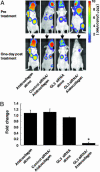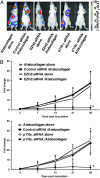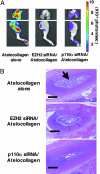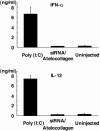Efficient delivery of small interfering RNA to bone-metastatic tumors by using atelocollagen in vivo
- PMID: 16091473
- PMCID: PMC1183487
- DOI: 10.1073/pnas.0501753102
Efficient delivery of small interfering RNA to bone-metastatic tumors by using atelocollagen in vivo
Abstract
Silencing of gene expression by small interfering RNAs (siRNAs) is rapidly becoming a powerful tool for genetic analysis and represents a potential strategy for therapeutic product development. However, there are no reports of systemic delivery for siRNAs toward treatment of bone-metastatic cancer. Accordingly, we report here that i.v. injection of GL3 luciferase siRNA complexed with atelocollagen showed effective reduction of luciferase expression from bone-metastatic prostate tumor cells developed in mouse thorax, jaws, and/or legs. We also show that the siRNA/atelocollagen complex can be efficiently delivered to tumors 24 h after injection and can exist intact at least for 3 days. Furthermore, atelocollagen-mediated systemic administration of siRNAs such as enhancer of zeste homolog 2 and phosphoinositide 3'-hydroxykinase p110-alpha-subunit, which were selected as candidate targets for inhibition of bone metastasis, resulted in an efficient inhibition of metastatic tumor growth in bone tissues. In addition, upregulation of serum IL-12 and IFN-alpha levels was not associated with the in vivo administration of the siRNA/atelocollagen complex. Thus, for treatment of bone metastasis of prostate cancer, an atelocollagen-mediated systemic delivery method could be a reliable and safe approach to the achievement of maximal function of siRNA.
Figures






Similar articles
-
Atelocollagen-mediated synthetic small interfering RNA delivery for effective gene silencing in vitro and in vivo.Nucleic Acids Res. 2004 Jul 22;32(13):e109. doi: 10.1093/nar/gnh093. Nucleic Acids Res. 2004. PMID: 15272050 Free PMC article.
-
Systemic delivery of siRNA specific to tumor mediated by atelocollagen: combined therapy using siRNA targeting Bcl-xL and cisplatin against prostate cancer.Int J Cancer. 2009 Dec 15;125(12):2978-90. doi: 10.1002/ijc.24382. Int J Cancer. 2009. PMID: 19422046
-
Efficient delivery of micro RNA to bone-metastatic prostate tumors by using aptamer-conjugated atelocollagen in vitro and in vivo.Drug Deliv. 2016;23(3):874-81. doi: 10.3109/10717544.2014.920059. Epub 2014 Jun 3. Drug Deliv. 2016. PMID: 24892627
-
[Application of atelocollagen-mediated siRNA delivery for RNAi therapies].Yakugaku Zasshi. 2007 May;127(5):807-12. doi: 10.1248/yakushi.127.807. Yakugaku Zasshi. 2007. PMID: 17473522 Review. Japanese.
-
Small Interfering RNAs and their Delivery Systems: A Novel Powerful Tool for the Potential Treatment of HIV Infections.Curr Mol Pharmacol. 2020;13(3):173-181. doi: 10.2174/1874467212666191023120954. Curr Mol Pharmacol. 2020. PMID: 31760929 Review.
Cited by
-
Photofrin based photodynamic therapy and miR-99a transfection inhibited FGFR3 and PI3K/Akt signaling mechanisms to control growth of human glioblastoma In vitro and in vivo.PLoS One. 2013;8(2):e55652. doi: 10.1371/journal.pone.0055652. Epub 2013 Feb 7. PLoS One. 2013. PMID: 23409016 Free PMC article.
-
Intraperitoneal delivery of a small interfering RNA targeting NEDD1 prolongs the survival of scirrhous gastric cancer model mice.Cancer Sci. 2013 Feb;104(2):214-22. doi: 10.1111/cas.12054. Epub 2012 Dec 13. Cancer Sci. 2013. PMID: 23106787 Free PMC article.
-
Therapeutic potential of RNA interference against cancer.Cancer Sci. 2006 Aug;97(8):689-96. doi: 10.1111/j.1349-7006.2006.00234.x. Cancer Sci. 2006. PMID: 16863503 Free PMC article. Review.
-
Identification of enhancer of zeste homolog 2 expression in peripheral circulating tumor cells in metastatic prostate cancer patients: a preliminary study.Yonsei Med J. 2007 Dec 31;48(6):1009-14. doi: 10.3349/ymj.2007.48.6.1009. Yonsei Med J. 2007. PMID: 18159594 Free PMC article.
-
Development of lipidoid-siRNA formulations for systemic delivery to the liver.Mol Ther. 2009 May;17(5):872-9. doi: 10.1038/mt.2009.36. Epub 2009 Mar 3. Mol Ther. 2009. PMID: 19259063 Free PMC article.
References
-
- Hannon, G. J. & Rossi, J. J. (2004) Nature 431, 371-378. - PubMed
-
- McCaffrey, A. P., Meuse, L., Pham, T. T., Conklin, D. S., Hannon, G. J. & Kay, M. A. (2002) Nature 418, 38-39. - PubMed
-
- Lewis, D. L., Hagstrom, J. E., Loomis, A. G., Wolff, J. A. & Herweijer, H. (2002) Nat. Genet. 32, 107-108. - PubMed
-
- Brummelkamp, T. R., Bernards, R. & Agami, R. (2002) Cancer Cell 2, 243-247. - PubMed
-
- Xia, H., Mao, Q., Paulson, H. L. & Davidson, B. L. (2002) Nat. Biotechnol. 20, 1006-1010. - PubMed
Publication types
MeSH terms
Substances
LinkOut - more resources
Full Text Sources
Other Literature Sources
Medical

